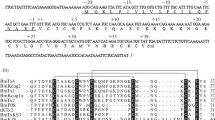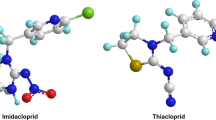Abstract
Nicotinic acetylcholine receptors (nAChRs) are the members of the cys-loop ligand-gated ion channel superfamily and are formed by five subunits arranged around a central ion channel. Each subunit is encoded by a separate gene and is classified as either α or non-α depending on the presence or absence, respectively, of two adjacent cysteine residues which are important for acetylcholine binding. Here, we report for the first time a single nAChR gene encoding both α and non-α subunits. Specifically, alternative splicing of the Anopheles gambiae nAChR subunit, previously called Agamα9 and renamed here Agamαβ9, generates two variants, one possessing the two cysteines (denoted Agamαβ9α) and the other lacking the cysteine doublet (Agamαβ9β). Attempts to heterologously express functional nAChRs consisting of the Agamαβ9 splice variants in Xenopus laevis oocytes were unsuccessful. Our findings further characterise a potential target to control the malaria mosquito as well as provide insights into the diversification of nAChRs.




Similar content being viewed by others
References
Altschul SF, Gish W, Miller W, Myers EW, Lipman DJ (1990) Basic local alignment search tool. J Mol Biol 215:403–410
Ballivet M, Alliod C, Bertrand S, Bertrand D (1996) Nicotinic acetylcholine receptors in the nematode Caenorhabditis elegans. J Mol Biol 258:261–269
Bentley GN, Jones AK, Oliveros Parra WG, Agnew A (2004) ShAR1alpha and ShAR1beta: novel putative nicotinic acetylcholine receptor subunits from the platyhelminth blood fluke Schistosoma. Gene 329:27–38
Bertrand D, Ballivet M, Gomez M, Bertrand S, Phannavong B, Gundelfinger ED (1994) Physiological properties of neuronal nicotinic receptors reconstituted from the vertebrate beta 2 subunit and Drosophila alpha subunits. Eur J Neurosci 6:869–875
Borges LS, Ferns M (2001) Agrin-induced phosphorylation of the acetylcholine receptor regulates cytoskeletal anchoring and clustering. J Cell Biol 153:1–12
Boulin T, Gielen M, Richmond JE, Williams DC, Paoletti P, Bessereau JL (2008) Eight genes are required for functional reconstitution of the Caenorhabditis elegans levamisole-sensitive acetylcholine receptor. Proc Natl Acad Sci USA 105:18590–18595
Bret BL (1997) Biological properties of spinosad. Down Earth 52:6–13
Buckingham SD, Pym L, Sattelle DB (2006) Oocytes as an expression system for studying receptor/channel targets of drugs and pesticides. Methods Mol Biol 322:331–345
Castillo M, Mulet J, Bernal JA, Criado M, Sala F, Sala S (2006) Improved gating of a chimeric alpha7-5HT3A receptor upon mutations at the M2-M3 extracellular loop. FEBS Lett 580:256–260
Corringer PJ, Le Novere N, Changeux JP (2000) Nicotinic receptors at the amino acid level. Annu Rev Pharmacol Toxicol 40:431–458
Couturier S, Bertrand D, Matter JM, Hernandez MC, Bertrand S, Millar N et al (1990) A neuronal nicotinic acetylcholine receptor subunit (alpha 7) is developmentally regulated and forms a homo-oligomeric channel blocked by alpha-BTX. Neuron 5:847–856
Dyrlov Bendtsen J, Nielsen H, Von Heijne G, Brunak S (2004) Improved prediction of signal peptides: SignalP 3.0. J Mol Biol 340:783–795
Felsenstein J (1985) Confidence limits on phylogenies: an approach using the bootstrap. Evolution 39:783–791
Gao JR, Deacutis JM, Scott JG (2007) The nicotinic acetylcholine receptor subunits Mdalpha5 and Mdbeta3 on autosome 1 of Musca domestica are not involved in spinosad resistance. Insect Mol Biol 16:691–701
Grauso M, Reenan RA, Culetto E, Sattelle DB (2002) Novel putative nicotinic acetylcholine receptor subunit genes, Dalpha5, Dalpha6 and Dalpha7, in Drosophila melanogaster identify a new and highly conserved target of adenosine deaminase acting on RNA-mediated A-to-I pre-mRNA editing. Genetics 160:1519–1533
Green WN, Wanamaker CP (1997) The role of the cystine loop in acetylcholine receptor assembly. J Biol Chem 272:20945–20953
Hemingway J, Hawkes NJ, McCarroll L, Ranson H (2004) The molecular basis of insecticide resistance in mosquitoes. Insect Biochem Mol Biol 34:653–665
Hopfield JF, Tank DW, Greengard P, Huganir RL (1988) Functional modulation of the nicotinic acetylcholine receptor by tyrosine phosphorylation. Nature 336:677–680
Hulo N, Bairoch A, Bulliard V, Cerutti L, De Castro E, Langendijk-Genevaux PS et al (2006) The PROSITE database. Nucleic Acids Res 34:D227–D230
Jensen ML, Schousboe A, Ahring PK (2005) Charge selectivity of the Cys-loop family of ligand-gated ion channels. J Neurochem 92:217–225
Jeschke P, Nauen R (2008) Neonicotinoids-from zero to hero in insecticide chemistry. Pest Manag Sci 64:1084–1098
Jin Y, Tian N, Cao J, Liang J, Yang Z, Lv J (2007) RNA editing and alternative splicing of the insect nAChR subunit alpha6 transcript: evolutionary conservation, divergence and regulation. BMC Evol Biol 7:98
Jones AK, Sattelle DB (2007) The cys-loop ligand-gated ion channel gene superfamily of the red flour beetle, Tribolium castaneum. BMC Genomics 8:327
Jones AK, Grauso M, Sattelle DB (2005) The nicotinic acetylcholine receptor gene family of the malaria mosquito, Anopheles gambiae. Genomics 85:176–187
Jones AK, Raymond-Delpech V, Thany SH, Gauthier M, Sattelle DB (2006) The nicotinic acetylcholine receptor gene family of the honey bee, Apis mellifera. Genome Res 16:1422–1430
Jones AK, Brown LA, Sattelle DB (2007a) Insect nicotinic acetylcholine receptor gene families: from genetic model organism to vector, pest and beneficial species. Invert Neurosci 7:67–73
Jones AK, Davis P, Hodgkin J, Sattelle DB (2007b) The nicotinic acetylcholine receptor gene family of the nematode Caenorhabditis elegans: an update on nomenclature. Invert Neurosci 7:129–131
Kao PN, Karlin A (1986) Acetylcholine receptor binding site contains a disulfide cross-link between adjacent half-cystinyl residues. J Biol Chem 261:8085–8088
Kerah-Hinzoumbe C, Peka M, Nwane P, Donan-Gouni I, Etang J, Same-Ekobo A et al (2008) Insecticide resistance in Anopheles gambiae from south-western Chad, Central Africa. Malar J 7:192
Lansdell SJ, Millar NS (2000) Cloning and heterologous expression of Dalpha4, a Drosophila neuronal nicotinic acetylcholine receptor subunit: identification of an alternative exon influencing the efficiency of subunit assembly. Neuropharmacology 39:2604–2614
Lansdell SJ, Millar NS (2002) Dbeta3, an atypical nicotinic acetylcholine receptor subunit from Drosophila: molecular cloning, heterologous expression and coassembly. J Neurochem 80:1009–1018
Lansdell SJ, Collins T, Yabe A, Gee VJ, Gibb AJ, Millar NS (2008) Host-cell specific effects of the nicotinic acetylcholine receptor chaperone RIC-3 revealed by a comparison of human and Drosophila RIC-3 homologues. J Neurochem 105:1573–1581
Le Novere N, Changeux JP (1995) Molecular evolution of the nicotinic acetylcholine receptor: an example of multigene family in excitable cells. J Mol Evol 40:155–172
Littleton JT, Ganetzky B (2000) Ion channels and synaptic organization: analysis of the Drosophila genome. Neuron 26:35–43
Matsuda K, Buckingham SD, Kleier D, Rauh JJ, Grauso M, Sattelle DB (2001) Neonicotinoids: insecticides acting on insect nicotinic acetylcholine receptors. Trends Pharmacol Sci 22:573–580
Millar NS (2008) RIC-3: a nicotinic acetylcholine receptor chaperone. Br J Pharmacol 153(Suppl 1):S177–S183
Millar NS, Denholm I (2007) Nicotinic acetylcholine receptors: targets for commercially important insecticides. Invert Neurosci 7:53–66
Millar NS, Gotti C (2008) Diversity of vertebrate nicotinic acetylcholine receptors. Neuropharmacology 56:237–246
Muller GC, Kravchenko VD, Schlein Y (2008) Decline of Anopheles sergentii and Aedes caspius populations following presentation of attractive toxic (spinosad) sugar bait stations in an oasis. J Am Mosq Control Assoc 24:147–149
Page RD (1996) TreeView: an application to display phylogenetic trees on personal computers. Comput Appl Biosci 12:357–358
Perez CM, Marina CF, Bond JG, Rojas JC, Valle J, Williams T (2007) Spinosad, a naturally derived insecticide, for control of Aedes aegypti (Diptera: Culicidae): efficacy, persistence, and elicited oviposition response. J Med Entomol 44:631–638
Saitou N, Nei M (1987) The neighbor-joining method: a new method for reconstructing phylogenetic trees. Mol Biol Evol 4:406–425
Sattelle DB, Jones AK, Sattelle BM, Matsuda K, Reenan R, Biggin PC (2005) Edit, cut and paste in the nicotinic acetylcholine receptor gene family of Drosophila melanogaster. Bioessays 27:366–376
Shao YM, Dong K, Zhang CX (2007) The nicotinic acetylcholine receptor gene family of the silkworm, Bombyx mori. BMC Genomics 8:324
Sine SM, Engel AG (2006) Recent advances in Cys-loop receptor structure and function. Nature 440:448–455
Szarecka A, Xu Y, Tang P (2007) Dynamics of heteropentameric nicotinic acetylcholine receptor: implications of the gating mechanism. Proteins 68:948–960
Tasneem A, Iyer LM, Jakobsson E, Aravind L (2005) Identification of the prokaryotic ligand-gated ion channels and their implications for the mechanisms and origins of animal Cys-loop ion channels. Genome Biol 6:R4
Thany SH, Lenaers G, Raymond-Delpech V, Sattelle DB, Lapied B (2007) Exploring the pharmacological properties of insect nicotinic acetylcholine receptors. Trends Pharmacol Sci 28:14–22
Thompson AJ, Lummis SC (2007) The 5-HT3 receptor as a therapeutic target. Expert Opin Ther Targets 11:527–540
Thompson JD, Gibson TJ, Plewniak F, Jeanmougin F, Higgins DG (1997) The CLUSTAL_X windows interface: flexible strategies for multiple sequence alignment aided by quality analysis tools. Nucleic Acids Res 25:4876–4882
Treinin M (2008) RIC-3 and nicotinic acetylcholine receptors: biogenesis, properties, and diversity. Biotechnol J 3:1539–1547
Unwin N (2005) Refined structure of the nicotinic acetylcholine receptor at 4A resolution. J Mol Biol 346:967–989
Yassin L, Gillo B, Kahan T, Halevi S, Eshel M, Treinin M (2001) Characterization of the deg-3/des-2 receptor: a nicotinic acetylcholine receptor that mutates to cause neuronal degeneration. Mol Cell Neurosci 17:589–599
Acknowledgments
The authors are indebted to the Anopheles gambiae Genome Project, which provided the starting point for this study. The authors thank Karen Day and Lynn Pilling for their help in providing mosquitoes.
Author information
Authors and Affiliations
Corresponding author
Rights and permissions
About this article
Cite this article
Jones, A.K., Buckingham, S.D., Brown, L.A. et al. Alternative splicing of the Anopheles gambiae nicotinic acetylcholine receptor, Agamαβ9, generates both alpha and beta subunits. Invert Neurosci 9, 77 (2009). https://doi.org/10.1007/s10158-009-0089-7
Received:
Accepted:
Published:
DOI: https://doi.org/10.1007/s10158-009-0089-7




